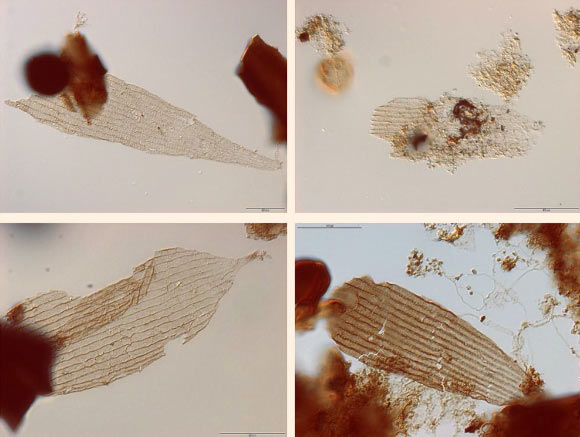An international group of paleontologists has found the oldest fossilized remains of insects from the order Lepidoptera known to date. The fossils, mostly wing scales, are more than 70 million years older than the oldest fossils of flowering plants, and they shed new light on the so-far presumed co-evolution between flowering plants and pollinating insects.

Fossilized scales of moths and butterflies from a drilled core in Germany. Image credit: van Eldijk et al.
The team, led by Utrecht University researchers Timo van Eldijk and Bas van de Schootbrugge, analyzed about 70 fossilized wing scales and scale fragments from a drilled core in northern Germany, which dates to the Triassic-Jurassic boundary (200 million years ago).
“The fossil remains contain distinctive hollow scales, and provide clear evidence for a group of moths with sucking mouthparts, which is related to the vast majority of living moths and butterflies,” Dr. van de Schootbrugge said.
“Modern day butterflies are well known for their association with flowering plants (angiosperms) and the butterfly ‘tongue’ has long been assumed to be an important adaptation for feeding on flowering plants.”
“The new evidence indicates that the first lepidopterans were associated with non-flowering seed plants (gymnosperms), the ecologically dominant plant group during the Jurassic.”
“The earliest proboscid moths (Glossata) likely used their sucking mouthparts to feed on the sugary pollination droplets secreted by several groups of gymnosperms.”
This shift in host food preference from gymnosperms to angiosperms challenges the notion that the development of the sucking proboscis was an adaptive response to the evolution of angiosperm flowers.
“The findings also suggest that the end-Triassic mass-extinction event 201 million years ago has not affected moths and butterflies, the researchers said.
“On the contrary, like dinosaurs, it is likely that the event triggered their expansion.”
“The mass extinction event occurred at the end of the Triassic and was associated with massive volcanism as the super continent Pangea started to break apart,” van Eldijk said.
“As a result, biodiversity on land and in the oceans suffered a setback with many key Triassic species going extinct, including many primitive reptiles.”
“However, one major group of insects, the Lepidoptera moths and butterflies, appeared unaffected. Instead, this group diversified during a period of ecological turnover.”
The results are published in the journal Science Advances.
_____
Timo J. B. van Eldijk et al. 2018. A Triassic-Jurassic window into the evolution of Lepidoptera. Science Advances 4 (1): e1701568; doi: 10.1126/sciadv.1701568







